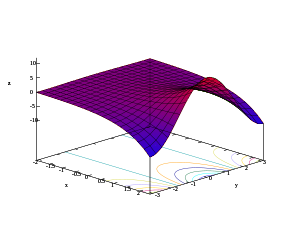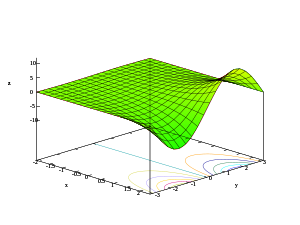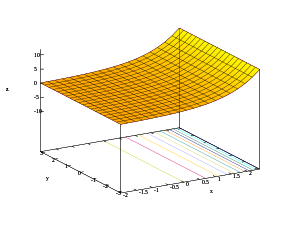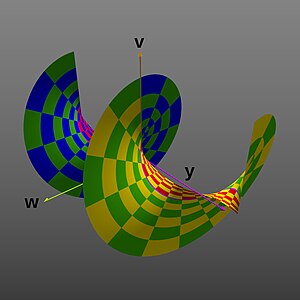Exponential function
| Exponential | |
|---|---|
 The natural exponential function along part of the real axis | |
| General information | |
| General definition | |
| Domain, codomain and image | |
| Domain | |
| Image | |
| Specific values | |
| At zero | 1 |
| Value at 1 | e |
| Specific features | |
| Fixed point | −Wn(−1) for |
| Related functions | |
| Reciprocal | |
| Inverse | Natural logarithm, Complex logarithm |
| Derivative | |
| Antiderivative | |
| Series definition | |
| Taylor series | |

In mathematics, the exponential function is the unique real function which maps zero to one and has a derivative equal to its value. The exponential of a variable is denoted or , with the two notations used interchangeably. It is called exponential because its argument can be seen as an exponent to which a constant number e ≈ 2.718, the base, is raised. There are several other definitions of the exponential function, which are all equivalent although being of very different nature.
The exponential function converts sums to products: it maps the additive identity 0 to the multiplicative identity 1, and the exponential of a sum is equal to the product of separate exponentials, . Its inverse function, the natural logarithm, or , converts products to sums: .
Other functions of the general form , with base , are also commonly called exponential functions, and share the property of converting addition to multiplication, . Where these two meanings might be confused, the exponential function of base is occasionally called the natural exponential function, matching the name natural logarithm. The generalization of the standard exponent notation to arbitrary real numbers as exponents, is usually formally defined in terms of the exponential and natural logarithm functions, as . The "natural" base is the unique base satisfying the criterion that the exponential function's derivative equals its value, , which simplifies definitions and eliminates extraneous constants when using exponential functions in calculus.
Quantities which change over time in proportion to their value, for example the balance of a bank account bearing compound interest, the size of a bacterial population, the temperature of an object relative to its environment, or the amount of a radioactive substance, can be modeled using functions of the form , also sometimes called exponential functions; these quantities undergo exponential growth if is positive or exponential decay if is negative.
The exponential function can be generalized to accept a complex number as its argument. This reveals a relation between the multiplication of complex numbers and rotation in the Euclidean plane, Euler's formula : the exponential of an imaginary number is a point on the complex unit circle at angle from the real axis. The identities of trigonometry can thus be translated into identities involving exponentials of imaginary quantities. The complex function is a conformal map from an infinite strip of the complex plane (which periodically repeats in the imaginary direction) onto the whole complex plane except for .
The exponential function can be even further generalized to accept other types of arguments, such as matrices and elements of Lie algebras. Some old texts refer to the exponential function as the antilogarithm.[1]
Graph
[edit]The graph of is upward-sloping, and increases faster as x increases.[2] The graph always lies above the x-axis, but becomes arbitrarily close to it for large negative x; thus, the x-axis is a horizontal asymptote. The equation means that the slope of the tangent to the graph at each point is equal to its height (its y-coordinate) at that point.
Definitions and fundamental properties
[edit]There are several different definitions of the exponential function, which are all equivalent, although of very dirrerent nature.
One of the simplest definition is: The exponential function is the unique differentiable function that equal its derivative, and takes the value 1 for the value 0 of its variable.
This "conceptual" definition requires a uniqueness proof and an existence proof, but it allows an easy derivation of the main properties of the exponential function.
Uniqueness: If and are two functions satisfying the above definition, then the derivative of is zero everywhere by the quotient rule. It follows that is constant, and this constant is 1 since .
The exponential function is the inverse function of the natural logarithm. The inverse function theorem implies that the natural logarithm has an inverse function, that satisfies the above definition. This is a first proof of existence. Therefore, one has
for every real number and evey positive real number
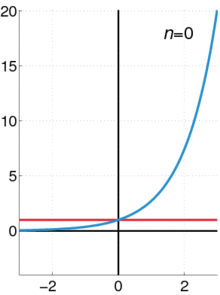
The exponential function is the sum of a power series:[3][4] where is the factorial of n (the product of the n first positive integers). This series is absolutely convergent for every per the ratio test. So, the derivative of the sum can be computed by term-by-term derivation, and this shows that the sum of the series satisfies the above definition. This is a second existence proof, and shows, as a byproduct that the exponential function is everywhere the sum of its Maclaurin series.
The exponential satisfies the functional equation: This results from the uniqueness and the fact that the function satisfies the above definition. It can be proved that a function that satisfies this functional equation is the exponential function if its derivative at 0 is 1 and the function is either continuous or monotonic
Positiveness: The exponential function is positive and monotonically increasing. The latter property results from the first one, since the derivative equals the function. The positiveness results for from the fact that all terms of the above series are positive. For this results from the functional identity that implies
Extension of exponentiation to positive real bases: Let b be a positive real number. The exponential function and the naturel logarithm being the inverse each of the other, one has If n is an integer, the functional equation of the logarithm implies Since the right-most expression is defined if n is any real number, this allows defining for every positive real number b and every real number x: In particular, if b is the Euler's number one has (inverse function) and thus This shows the equivalence of the two notations for the exponential function.
The exponential function is the limit[5][4] where takes only integer values (otherwise, the exponentiation would require the xponential function to be defined). By continuity of the logarithm, this can be proved by taking logarithms and proving for example with Taylor's theorem.
General exponential functions
[edit]The exponential function is sometimes called the natural exponential function to distinguish it from the other exponential functions. The study of any exponential function can easily be reduced to that of the natural exponential function, since per definition, for positive b, As functions of a real variable, exponential functions are uniquely characterized by the fact that the derivative of such a function is directly proportional to the value of the function. The constant of proportionality of this relationship is the natural logarithm of the base b: Let be a positive coefficient. For , the function is increasing (as depicted for b = e and b = 2), because makes the derivative always positive, and describes exponential growth. For , the function is decreasing (as depicted for b = 1/2), and describes exponential decay. For b = 1, the function is constant.
Euler's number e = 2.71828...[6] is the unique base for which the constant of proportionality is 1, since , so that the function is its own derivative:
This function, also denoted as , is called the "natural exponential function",[7][8] or simply "the exponential function", denoted asThe former notation is commonly used for simpler exponents, while the latter is preferred when the exponent is more complicated and harder to read in a small font. Since any exponential function can be written in terms of the natural exponential, it is computationally and conceptually convenient to reduce the study of exponential functions to this particular one.
For real numbers , a function of the form is also an exponential function:
Overview
[edit]
The exponential function arises whenever a quantity grows or decays at a rate proportional to its current value. One such situation is continuously compounded interest, and in fact it was this observation that led Jacob Bernoulli in 1683[9] to the number now known as e. Later, in 1697, Johann Bernoulli studied the calculus of the exponential function.[9]
If a principal amount of 1 earns interest at an annual rate of x compounded monthly, then the interest earned each month is x/12 times the current value, so each month the total value is multiplied by (1 + x/12), and the value at the end of the year is (1 + x/12)12. If instead interest is compounded daily, this becomes (1 + x/365)365. Letting the number of time intervals per year grow without bound leads to the limit definition of the exponential function, first given by Leonhard Euler.[5] This is one of a number of characterizations of the exponential function; others involve series or differential equations.
From any of these definitions it can be shown that e−x is the reciprocal of ex. For example, from the differential equation definition, ex e−x = 1 when x = 0 and its derivative using the product rule is ex e−x − ex e−x = 0 for all x, so ex e−x = 1 for all x.
From any of these definitions it can be shown that the exponential function obeys the basic exponentiation identity. For example, from the power series definition, expanded by the Binomial theorem, This justifies the exponential notation ex for exp x.
The derivative (rate of change) of the exponential function is the exponential function itself. More generally, a function with a rate of change proportional to the function itself is expressible in terms of the exponential function. This derivative property leads to exponential growth or exponential decay.
The exponential function extends to an entire function on the complex plane. Euler's formula relates its values at purely imaginary arguments to trigonometric functions. The exponential function also has analogues for which the argument is a matrix, or even an element of a Banach algebra or a Lie algebra.
Derivatives and differential equations
[edit]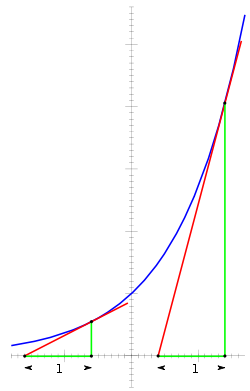
The importance of the exponential function in mathematics and the sciences stems mainly from its property as the unique function which is equal to its derivative and is equal to 1 when x = 0. That is,
Functions of the form aex for constant a are the only functions that are equal to their derivative (by the Picard–Lindelöf theorem). Other ways of saying the same thing include:
- The slope of the graph at any point is the height of the function at that point.
- The rate of increase of the function at x is equal to the value of the function at x.
- The function solves the differential equation y′ = y.
- exp is a fixed point of derivative as a linear operator on function space.
If a variable's growth or decay rate is proportional to its size—as is the case in unlimited population growth (see Malthusian catastrophe), continuously compounded interest, or radioactive decay—then the variable can be written as a constant times an exponential function of time.
More generally, for any real constant k, a function f: R → R satisfies if and only if for some constant a. The constant k is called the decay constant, disintegration constant,[10] rate constant,[11] or transformation constant.[12]
Furthermore, for any differentiable function f, we find, by the chain rule:
Continued fractions for ex
[edit]A continued fraction for ex can be obtained via an identity of Euler:
The following generalized continued fraction for ez converges more quickly:[13]
or, by applying the substitution z = x/y: with a special case for z = 2:
This formula also converges, though more slowly, for z > 2. For example:
Complex plane
[edit]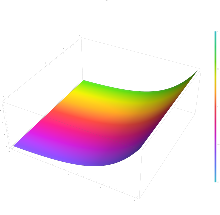
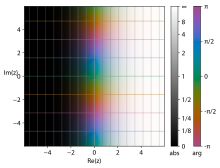
As in the real case, the exponential function can be defined on the complex plane in several equivalent forms.
The most common definition of the complex exponential function parallels the power series definition for real arguments, where the real variable is replaced by a complex one:
Alternatively, the complex exponential function may be defined by modelling the limit definition for real arguments, but with the real variable replaced by a complex one:
For the power series definition, term-wise multiplication of two copies of this power series in the Cauchy sense, permitted by Mertens' theorem, shows that the defining multiplicative property of exponential functions continues to hold for all complex arguments:
The definition of the complex exponential function in turn leads to the appropriate definitions extending the trigonometric functions to complex arguments.
In particular, when z = it (t real), the series definition yields the expansion
In this expansion, the rearrangement of the terms into real and imaginary parts is justified by the absolute convergence of the series. The real and imaginary parts of the above expression in fact correspond to the series expansions of cos t and sin t, respectively.
This correspondence provides motivation for defining cosine and sine for all complex arguments in terms of and the equivalent power series:[14]
for all
The functions exp, cos, and sin so defined have infinite radii of convergence by the ratio test and are therefore entire functions (that is, holomorphic on ). The range of the exponential function is , while the ranges of the complex sine and cosine functions are both in its entirety, in accord with Picard's theorem, which asserts that the range of a nonconstant entire function is either all of , or excluding one lacunary value.
These definitions for the exponential and trigonometric functions lead trivially to Euler's formula:
We could alternatively define the complex exponential function based on this relationship. If z = x + iy, where x and y are both real, then we could define its exponential as where exp, cos, and sin on the right-hand side of the definition sign are to be interpreted as functions of a real variable, previously defined by other means.[15]
For , the relationship holds, so that for real and maps the real line (mod 2π) to the unit circle in the complex plane. Moreover, going from to , the curve defined by traces a segment of the unit circle of length starting from z = 1 in the complex plane and going counterclockwise. Based on these observations and the fact that the measure of an angle in radians is the arc length on the unit circle subtended by the angle, it is easy to see that, restricted to real arguments, the sine and cosine functions as defined above coincide with the sine and cosine functions as introduced in elementary mathematics via geometric notions.
The complex exponential function is periodic with period 2πi and holds for all .
When its domain is extended from the real line to the complex plane, the exponential function retains the following properties:
for all
Extending the natural logarithm to complex arguments yields the complex logarithm log z, which is a multivalued function.
We can then define a more general exponentiation: for all complex numbers z and w. This is also a multivalued function, even when z is real. This distinction is problematic, as the multivalued functions log z and zw are easily confused with their single-valued equivalents when substituting a real number for z. The rule about multiplying exponents for the case of positive real numbers must be modified in a multivalued context:
≠ ezw, but rather (ez)w
= e(z + 2niπ)w multivalued over integers n
See failure of power and logarithm identities for more about problems with combining powers.
The exponential function maps any line in the complex plane to a logarithmic spiral in the complex plane with the center at the origin. Two special cases exist: when the original line is parallel to the real axis, the resulting spiral never closes in on itself; when the original line is parallel to the imaginary axis, the resulting spiral is a circle of some radius.
- 3D plots of real part, imaginary part, and modulus of the exponential function
-
z = Re(ex + iy)
-
z = Im(ex + iy)
-
z = |ex + iy|
Considering the complex exponential function as a function involving four real variables: the graph of the exponential function is a two-dimensional surface curving through four dimensions.
Starting with a color-coded portion of the domain, the following are depictions of the graph as variously projected into two or three dimensions.
- Graphs of the complex exponential function
-
Checker board key:
-
Projection onto the range complex plane (V/W). Compare to the next, perspective picture.
-
Projection into the , , and dimensions, producing a flared horn or funnel shape (envisioned as 2-D perspective image)
-
Projection into the , , and dimensions, producing a spiral shape ( range extended to ±2π, again as 2-D perspective image)
The second image shows how the domain complex plane is mapped into the range complex plane:
- zero is mapped to 1
- the real axis is mapped to the positive real axis
- the imaginary axis is wrapped around the unit circle at a constant angular rate
- values with negative real parts are mapped inside the unit circle
- values with positive real parts are mapped outside of the unit circle
- values with a constant real part are mapped to circles centered at zero
- values with a constant imaginary part are mapped to rays extending from zero
The third and fourth images show how the graph in the second image extends into one of the other two dimensions not shown in the second image.
The third image shows the graph extended along the real axis. It shows the graph is a surface of revolution about the axis of the graph of the real exponential function, producing a horn or funnel shape.
The fourth image shows the graph extended along the imaginary axis. It shows that the graph's surface for positive and negative values doesn't really meet along the negative real axis, but instead forms a spiral surface about the axis. Because its values have been extended to ±2π, this image also better depicts the 2π periodicity in the imaginary value.
Computation of ab where both a and b are complex
[edit]Complex exponentiation ab can be defined by converting a to polar coordinates and using the identity eb ln a = ab:
with being an argument of . However, when b is not an integer, this function is multivalued, because θ is not unique (see Exponentiation § Failure of power and logarithm identities). The quotient cannot be defined in this way since is not defined. The choice of the principal value of satisfies , and this also defines the principal value of .
Power functions and exponential function with a complex base
[edit]Given a complex number and once we have defined the principal value of , we may define the single-valued functions (known as the power function) and , which is similiar to the exponential function but the base can be a complex number. If is not an integer, then has discontinuities at negative reals, since and this follows from the fact that the complex logarithm function is discontinuous at the negative reals. The Maclaurin series of function is given by This is known as the binomial series. In addition, if has a positive real part, then the series converges absolutely for , and the limit of also exists as within the unit circle and is equal to , so we may also define . If has a non-positive real part and then the series diverges, so remains undefined. The expression is left undefined because it is an indeterminate form in calculus. The function defined here is holomorphic everywhere in the complex plane, and thus it is entire. The Maclaurin series of is given by
Matrices and Banach algebras
[edit]The power series definition of the exponential function makes sense for square matrices (for which the function is called the matrix exponential) and more generally in any unital Banach algebra B. In this setting, e0 = 1, and ex is invertible with inverse e−x for any x in B. If xy = yx, then ex + y = exey, but this identity can fail for noncommuting x and y.
Some alternative definitions lead to the same function. For instance, ex can be defined as
Or ex can be defined as fx(1), where fx : R → B is the solution to the differential equation dfx/dt(t) = x fx(t), with initial condition fx(0) = 1; it follows that fx(t) = etx for every t in R.
Lie algebras
[edit]Given a Lie group G and its associated Lie algebra , the exponential map is a map ↦ G satisfying similar properties. In fact, since R is the Lie algebra of the Lie group of all positive real numbers under multiplication, the ordinary exponential function for real arguments is a special case of the Lie algebra situation. Similarly, since the Lie group GL(n,R) of invertible n × n matrices has as Lie algebra M(n,R), the space of all n × n matrices, the exponential function for square matrices is a special case of the Lie algebra exponential map.
The identity can fail for Lie algebra elements x and y that do not commute; the Baker–Campbell–Hausdorff formula supplies the necessary correction terms.
Transcendency
[edit]The function ez is not in the rational function ring : it is not the quotient of two polynomials with complex coefficients.
If a1, ..., an are distinct complex numbers, then ea1z, ..., eanz are linearly independent over , and hence ez is transcendental over .
Computation
[edit]The Taylor series definition above is generally efficient for computing (an approximation of) . However, when computing near the argument , the result will be close to 1, and computing the value of the difference with floating-point arithmetic may lead to the loss of (possibly all) significant figures, producing a large relative error, possibly even a meaningless result.
Following a proposal by William Kahan, it may thus be useful to have a dedicated routine, often called expm1, which computes ex − 1 directly, bypassing computation of ex. For example,
one may use the Taylor series:
This was first implemented in 1979 in the Hewlett-Packard HP-41C calculator, and provided by several calculators,[16][17] operating systems (for example Berkeley UNIX 4.3BSD[18]), computer algebra systems, and programming languages (for example C99).[19]
In addition to base e, the IEEE 754-2008 standard defines similar exponential functions near 0 for base 2 and 10: and .
A similar approach has been used for the logarithm (see lnp1).[nb 1]
An identity in terms of the hyperbolic tangent, gives a high-precision value for small values of x on systems that do not implement expm1(x).
See also
[edit]- Carlitz exponential, a characteristic p analogue
- Double exponential function – Exponential function of an exponential function
- Exponential field – Mathematical field with an extra operation
- Gaussian function
- Half-exponential function, a compositional square root of an exponential function
- Lambert_W_function#Solving_equations – Multivalued function in mathematics - Used for solving exponential equations
- List of exponential topics
- List of integrals of exponential functions
- Mittag-Leffler function, a generalization of the exponential function
- p-adic exponential function
- Padé table for exponential function – Padé approximation of exponential function by a fraction of polynomial functions
- Phase factor
Notes
[edit]- ^ A similar approach to reduce round-off errors of calculations for certain input values of trigonometric functions consists of using the less common trigonometric functions versine, vercosine, coversine, covercosine, haversine, havercosine, hacoversine, hacovercosine, exsecant and excosecant.
Cite error: A list-defined reference named "Logx" is not used in the content (see the help page).
References
[edit]- ^ Converse, Henry Augustus; Durell, Fletcher (1911). Plane and Spherical Trigonometry. Durell's mathematical series. C. E. Merrill Company. p. 12.
Inverse Use of a Table of Logarithms; that is, given a logarithm, to find the number corresponding to it, (called its antilogarithm) ...
[1] - ^ "Exponential Function Reference". www.mathsisfun.com. Retrieved 2020-08-28.
- ^ Rudin, Walter (1987). Real and complex analysis (3rd ed.). New York: McGraw-Hill. p. 1. ISBN 978-0-07-054234-1.
- ^ a b Weisstein, Eric W. "Exponential Function". mathworld.wolfram.com. Retrieved 2020-08-28.
- ^ a b Maor, Eli. e: the Story of a Number. p. 156.
- ^ Sloane, N. J. A. (ed.). "Sequence A001113 (Decimal expansion of e)". The On-Line Encyclopedia of Integer Sequences. OEIS Foundation.
- ^ Goldstein, Larry Joel; Lay, David C.; Schneider, David I.; Asmar, Nakhle H. (2006). Brief calculus and its applications (11th ed.). Prentice–Hall. ISBN 978-0-13-191965-5. (467 pages)
- ^ Courant; Robbins (1996). Stewart (ed.). What is Mathematics? An Elementary Approach to Ideas and Methods (2nd revised ed.). Oxford University Press. p. 448. ISBN 978-0-13-191965-5.
This natural exponential function is identical with its derivative. This is really the source of all the properties of the exponential function, and the basic reason for its importance in applications…
- ^ a b O'Connor, John J.; Robertson, Edmund F. (September 2001). "The number e". School of Mathematics and Statistics. University of St Andrews, Scotland. Retrieved 2011-06-13.
- ^ Serway, Raymond A.; Moses, Clement J.; Moyer, Curt A. (1989). Modern Physics. Fort Worth: Harcourt Brace Jovanovich. p. 384. ISBN 0-03-004844-3.
- ^ Simmons, George F. (1972). Differential Equations with Applications and Historical Notes. New York: McGraw-Hill. p. 15. LCCN 75173716.
- ^ McGraw-Hill Encyclopedia of Science & Technology (10th ed.). New York: McGraw-Hill. 2007. ISBN 978-0-07-144143-8.
- ^ Lorentzen, L.; Waadeland, H. (2008). "A.2.2 The exponential function.". Continued Fractions. Atlantis Studies in Mathematics. Vol. 1. p. 268. doi:10.2991/978-94-91216-37-4. ISBN 978-94-91216-37-4.
- ^ Rudin, Walter (1976). Principles of Mathematical Analysis. New York: McGraw-Hill. p. 182. ISBN 978-0-07-054235-8.
- ^ Apostol, Tom M. (1974). Mathematical Analysis (2nd ed.). Reading, Mass.: Addison Wesley. pp. 19. ISBN 978-0-201-00288-1.
- ^ HP 48G Series – Advanced User's Reference Manual (AUR) (4 ed.). Hewlett-Packard. December 1994 [1993]. HP 00048-90136, 0-88698-01574-2. Retrieved 2015-09-06.
- ^ HP 50g / 49g+ / 48gII graphing calculator advanced user's reference manual (AUR) (2 ed.). Hewlett-Packard. 2009-07-14 [2005]. HP F2228-90010. Retrieved 2015-10-10. [2]
- ^ Beebe, Nelson H. F. (2017-08-22). "Chapter 10.2. Exponential near zero". The Mathematical-Function Computation Handbook - Programming Using the MathCW Portable Software Library (1 ed.). Salt Lake City, UT, USA: Springer International Publishing AG. pp. 273–282. doi:10.1007/978-3-319-64110-2. ISBN 978-3-319-64109-6. LCCN 2017947446. S2CID 30244721.
Berkeley UNIX 4.3BSD introduced the expm1() function in 1987.
- ^ Beebe, Nelson H. F. (2002-07-09). "Computation of expm1 = exp(x)−1" (PDF). 1.00. Salt Lake City, Utah, USA: Department of Mathematics, Center for Scientific Computing, University of Utah. Retrieved 2015-11-02.
External links
[edit]- "Exponential function", Encyclopedia of Mathematics, EMS Press, 2001 [1994]



























































































![{\displaystyle {\begin{aligned}&\cos z:={\frac {\exp(iz)+\exp(-iz)}{2}}=\sum _{k=0}^{\infty }(-1)^{k}{\frac {z^{2k}}{(2k)!}},\\[5pt]{\text{and }}\quad &\sin z:={\frac {\exp(iz)-\exp(-iz)}{2i}}=\sum _{k=0}^{\infty }(-1)^{k}{\frac {z^{2k+1}}{(2k+1)!}}\end{aligned}}}](https://wikimedia.org/api/rest_v1/media/math/render/svg/5cd4c31e93df2a42004f0646e7388ebceb559cf6)















![{\displaystyle {\begin{aligned}&e^{z+w}=e^{z}e^{w}\,\\[5pt]&e^{0}=1\,\\[5pt]&e^{z}\neq 0\\[5pt]&{\frac {d}{dz}}e^{z}=e^{z}\\[5pt]&\left(e^{z}\right)^{n}=e^{nz},n\in \mathbb {Z} \end{aligned}}}](https://wikimedia.org/api/rest_v1/media/math/render/svg/2a02a91bb0f949ab159767d68857e617d7bce4a8)


